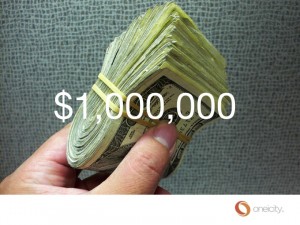This week’s interview with Seth Godin sparked discussion on the blog, FB page and on the backchannel. It was great fun and nearly everything we’d hoped for (it’s early yet, maybe it will turn into “everything” we’d hoped for, we’ll see).
One of the comments that Seth made grabbed the attention of many of our readers: “Last year Americans spent more than six billion dollars on self-storage facilities. What are we storing?”  He used that statistic and the question to illustrate the potential for philanthropy in the US.
He used that statistic and the question to illustrate the potential for philanthropy in the US.
From my perspective, he also illustrated the power of “framing context.” Maybe “framing context” isn’t exactly the right phrase, but it’s what I’m going with for now.
If Seth had just said: “we can and should give more to great causes!” We’d have nodded and yawned.
If Seth had said “Americans give less than X% of their income to charities.” We’d have agreed and yawned.
If Seth had noted that Americans spent $5.5 billion dollars on bicycles last year we’d have wondered about it but not been moved. And probably ridden off on our mental bicycles thinking about all the advantages switching from cars to bicycles.
But he talked about storage units. Huh? Storage units. Americans spent $6 billion on storage units. And then he framed it with a question so that it stuck with us (and hooked us): “What are we storing?” The reality of the dollars spent on storage units and then his question did what he wanted done. It made us think of all the junk we or someone we know has stored. We thought of all useless stuff we have in the basement. And then, because he knows his audience, his strategy worked to turn the corner on how those dollars could be used to change the world, feed a child, cure a disease…all the things you and I live to do.
When you’re trying to make an impact in your communication, use a startling fact and then drive the point home by framing the context. Statistics without a frame to give context are meaningless, boring and dangerous.
Without his question framing the context, we might have wondered, “Is that more than previous years or less?” I have to tell you I have no idea whether $6 billion is a 10 year high or a 10 year low. His question kept me from going there. He kept me focused where he wanted me.
If you’re a rescue mission, you talk about serving 10,000 meals a month. Is that more than last year? If so, be sure your readers know it and know that’s another reason their partnership is important. Help them know you’ve experienced a 15% growth. If it is less than last year, remind people that it 10,000 meals is more school lunches than your local high school serves in a month…or some way for people to “see” the picture you’re framing for them. Set the context, don’t allow your audience to set it.
You get the picture but I thought I’d remind us all about the power of “framing the context.” And I loved seeing a pro like Seth do it so naturally.
Hoots uses this photo in her I Love Data presentation. She asks the question: “Is this a good number or a bad number?” It is always interesting to hear the group jump back and forth. “Good.” “Bad.” “No, good.” then finally: “Well it depends…” Her point is that numbers out of context are meaningless.
She asks the question: “Is this a good number or a bad number?” It is always interesting to hear the group jump back and forth. “Good.” “Bad.” “No, good.” then finally: “Well it depends…” Her point is that numbers out of context are meaningless.
I’d say it this way, frame the context for you audience to persuade. And I’d ask, what are you storing in all those storage units?
What do you think about Seth’s point or how he made his point? Love hearing what you’re thinking. Don’t forget that anyone who comments has a chance to win the Whole Seth Godin Enchilada book giveaway.
Jump in. You make the conversation richer. Thanks for dropping by.

Steve Thomas
Partner, Oneicity
(photo credit: St_A_Sh)

3 thoughts on “billions on storage units”
Your elaboration on this point is instructive and much appreciated. Thank you for spelling out exactly how he inserted the statistic of the storage units in the context of charitable giving and why it matters. Also agree, the question, “What are we storing?” was just as important as the statistic alone. I can’t think of anything more effective and powerful for nonprofits to do in their marketing communications than provide context – especially with provocative questions like that one.
p.s. I like whole enchiladas. But they rarely motivate me. People, like you, do. 🙂
@Deborah — thanks so much for your thoughts. I’m always motivated by enchiladas…and energized by you!
st
“Statistics without a frame to give context are meaningless, boring and dangerous.” ST
Great point – It’s probably of little importance that the stat is remembered by the reader than the emotional impact made by framing the context. i may not remember all the details perfectly but one example that sticks with me is from a book i read 12 years ago discussed the number of advertisements an individual encountered back then. I’m sure he/she used a stat that i’ve long forgotten. But the reason i remember the discussion today is because he framed the context by saying an individual encountered more ads on the way to work than a pioneer would have in their entire life. A very sticky idea that obviously left an impression at least with this reader.